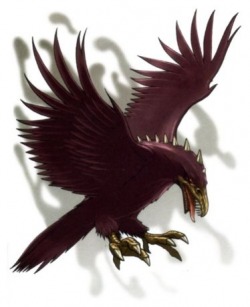Bonegnawers are large birds of prey native to the Jundland Wastes of Tatooine. They are admired and respected for their grace and beauty by the planet's inhabitants. However, they also have a fearsome reputation because of their speed and a pair of jaws that are reputed to be capable of crushing rock.
Bonegnawers had a lifespan of thirty to forty years. Baby bonegnawers, also known as "gnawlets", can make sound within hours, but it would be a matter of a few days before they gained sight. The diet of gnawlets consists of marrow extracted from the bones of their parents' prey. They bore little resemblance to the striking birds that they would grow up to be. Young bonegnawers typically remained with their parents until they were capable of defending themselves, which was about three years from the day that they were born.
Upon leaving their parents, male bonegnawers will set out on their own and try to find areas that are not protected by other males. A male bonegnawer's dominion covers an area of approximately 30 kilometers in diameter from his nest, and it serves as his hunting grounds. Male bonegnawers are extremely territorial creatures and defend their dominion if it is trespassed upon by other males or mated pairs.
Females, on the other hand, embrace communal living initially by forming a flock with their sisters. They eventually form larger flocks with other females, who nest together and try not to make other creatures leave their area. Female bonegnawers do most of their hunting when Tatoo I and Tatoo II (Tatooine's moons) have sunken below the horizon.
Adult bonegnawers of both sexes have a scarlet breast and tail, as well as a black beak. Their wingspan ranges from 25 to 30 feet, which made their colorful plumage visible from long distances. The color of a male's wings ranges from a deep purple to a bright blue while the female's wings appear to be golden.
After mating, adult bonegnawers form a permanent bond with each other. This bond causes them to shun contact with all other bonegnawers. The territory of a mated pair is approximately 1100 yards in diameter from their nest, and they are just as protective of their territory as a solitary male could be expected to be. This is especially true when the pair are parents.
The nests of bonegnawers are carved out of large rocks in Tatooine's wastes. Since they are not migratory, bonegnawers would only relocate under adverse circumstances. Bonegnawer nests are often littered with the shards of the bones of their prey - something of a testament to their rather unique diet.
For hunting, bonegnawers are equipped with strong eyes, which they used to spot prey such as womp rats, young banthas and humanoids from a great distance. They can see twice as far as a Human and can even distinguish different colors in poorly lit areas. Most surface creatures are unable to outrun bonegnawers since their wings allowed them to be both fast and silent. They will catch smaller prey in their beaks and try to kill larger prey by slamming it into the ground at high speeds. The rows of teeth and the strong jaws of the bonegnawer's beak allow them to get to what appears to be their favorite prey - young cliffborer worms.
Bonegnawers consume the meat of their prey right where they kill it, but bring the prey's bones back to their nest. Over the course of several days, bonegnawers crack open the bones and will either feed the marrow to gnawlings or eat it themselves. It is from this behavior that the bonegnawer gained its name.
Bonegnawers will breed only three or for times during their lifetime. Of the eight to ten eggs that the female lays, four to seven will not make it to the point of hatching after fourteen months. This is usually due to the eggs being moved in the wrong way, being exposed to cold for too long a period, or falling prey to natural predators and poachers.
Though the bonegnawer is feared by many natives of Tatooine, it was also respected by them - especially the Tusken Raiders, who view them as emblematic of strength and courage. Swoop riders, landspeeder racers and skyhopper pilots believed that they serve as great decals for their vehicles.
Others see bonegnawers as a lucrative business. Since gnawlets fixated on the first creature that they see with their eyes as a parent, bonegnawers were easily domesticable creatures and made great hunters and guard animals. The financial benefits that come from the sale of gnawlets resulted in hunters and poachers taking extreme risks to steal the eggs from their parents.

